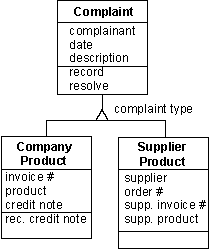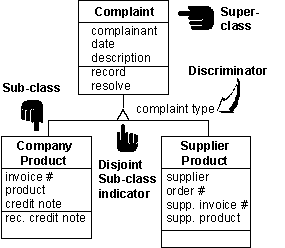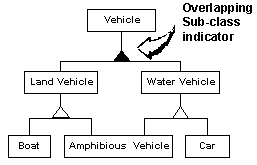Concept: Inheritance
 Inheritance is
a type of relationship among classes, wherein one class shares
the structure or behaviour defined in one (single inheritance) or
more (multiple inheritance) other classes. Inheritance defines a
"kind of" hierarchy among classes in which a sub class
inherits from one or more super-classes; a sub-class typically
augments or redefines the existing structure and behaviour of its
super-classes. [25]
Inheritance is
a type of relationship among classes, wherein one class shares
the structure or behaviour defined in one (single inheritance) or
more (multiple inheritance) other classes. Inheritance defines a
"kind of" hierarchy among classes in which a sub class
inherits from one or more super-classes; a sub-class typically
augments or redefines the existing structure and behaviour of its
super-classes. [25]
The example models a fragment of a complaint resolution
system. It models the fact that a complaint can either be about
the company's product or a product purchased by the company from
a supplier. The former complaint would originate from a customer,
the latter would originate from within the company itself. In
both cases the complainant details, date and description of
complaint are recorded. These attributes therefore remain with
the super-class "complaint" which models the general
case. In the special case of the company product however invoice,
credit note and product information needs to be recorded. These
attributes are therefore modeled as being unique to the
"company product" sub-class. In the case of the
supplier product, supplier information, order number, supplier
invoice and supplier product information must be recorded. These
attributes are therefore unique to the "supplier
product" sub-class. In both cases the attributes of the
super-class "complaint" plus the attributes of the
individual sub-classes completely define the attributes of that
sub-class.
In both cases the complaint needs to be recorded and resolved.
These operations therefore remain with the super-class
"complaint". In the case of a sub-class "company
product" a credit note needs to be recorded. This operation
therefore augments the operations of this sub-class. As with the
attributes the operations of the super-class
"complaint" plus the operations of the individual
sub-classes completely define the operations of that sub-class.
The sub-classes are said to inherit
the attributes and operations of their super-class.

- A sub-class is a specialisation of its parent
class
- All sub-classes inherit the super-class
attributes & operations
- Each sub-class has unique attributes &
operations
- A sub-class may override features of a parent
class by defining one with the same name
|
 |

Multiple inheritance permits a class to
have more than one super-class and to inherit features
from all parents.
- A class may inherit features from more than one
super-class
- If parent classes have the same features they are
inherited only once
- Conflicts among parallel features must be
explicitly resolved by disabling the inheritance
of a specific feature
|
 |
In the example an amphibious vehicle has the characteristics
of both a land vehicle and a water vehicle. It therefore exhibits
multiple inheritance from both these classes.

Software Engineering Web
Copyright ã 1997 Chambers & Associates Pty Ltd
Module: 104 v1.0 c_inhert.htm
Updated: July 02, 2006
 Inheritance is
a type of relationship among classes, wherein one class shares
the structure or behaviour defined in one (single inheritance) or
more (multiple inheritance) other classes. Inheritance defines a
"kind of" hierarchy among classes in which a sub class
inherits from one or more super-classes; a sub-class typically
augments or redefines the existing structure and behaviour of its
super-classes. [25]
Inheritance is
a type of relationship among classes, wherein one class shares
the structure or behaviour defined in one (single inheritance) or
more (multiple inheritance) other classes. Inheritance defines a
"kind of" hierarchy among classes in which a sub class
inherits from one or more super-classes; a sub-class typically
augments or redefines the existing structure and behaviour of its
super-classes. [25]
